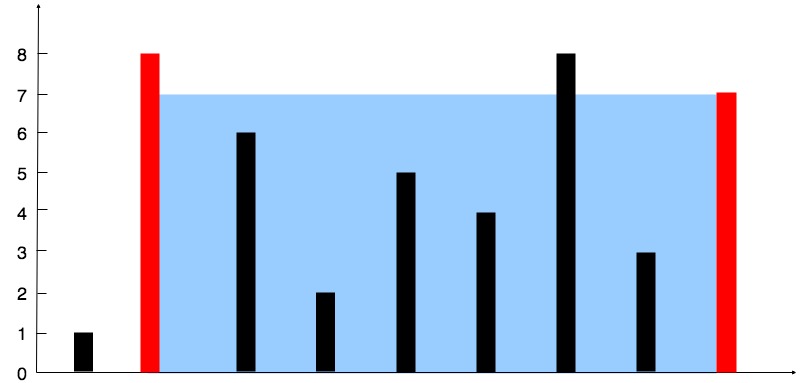g0001_0100.s0011_container_with_most_water.readme.md Maven / Gradle / Ivy
Go to download
Show more of this group Show more artifacts with this name
Show all versions of leetcode-in-java21 Show documentation
Show all versions of leetcode-in-java21 Show documentation
Java-based LeetCode algorithm problem solutions, regularly updated
11\. Container With Most Water
Medium
Given `n` non-negative integers a1, a2, ..., an , where each represents a point at coordinate (i, ai). `n` vertical lines are drawn such that the two endpoints of the line `i` is at (i, ai) and `(i, 0)`. Find two lines, which, together with the x-axis forms a container, such that the container contains the most water.
**Notice** that you may not slant the container.
**Example 1:**

**Input:** height = [1,8,6,2,5,4,8,3,7]
**Output:** 49
**Explanation:** The above vertical lines are represented by array [1,8,6,2,5,4,8,3,7]. In this case, the max area of water (blue section) the container can contain is 49.
**Example 2:**
**Input:** height = [1,1]
**Output:** 1
**Example 3:**
**Input:** height = [4,3,2,1,4]
**Output:** 16
**Example 4:**
**Input:** height = [1,2,1]
**Output:** 2
**Constraints:**
* `n == height.length`
* 2 <= n <= 105
* 0 <= height[i] <= 104
To solve the Container With Most Water problem in Java using a `Solution` class, we'll follow these steps:
1. Define a `Solution` class with a method named `maxArea` that takes an array of integers `height` as input and returns the maximum area of water that can be contained.
2. Initialize two pointers, `left` pointing to the start of the array and `right` pointing to the end of the array.
3. Initialize a variable `maxArea` to store the maximum area encountered so far, initially set to 0.
4. Iterate while `left` is less than `right`.
5. Calculate the current area using the formula: `(right - left) * min(height[left], height[right])`.
6. Update `maxArea` if the current area is greater than `maxArea`.
7. Move the pointer pointing to the smaller height towards the other pointer. If `height[left] < height[right]`, increment `left`, otherwise decrement `right`.
8. Continue the iteration until `left` becomes greater than or equal to `right`.
9. Return `maxArea`.
Here's the implementation:
```java
public class Solution {
public int maxArea(int[] height) {
int left = 0;
int right = height.length - 1;
int maxArea = 0;
while (left < right) {
int currentArea = (right - left) * Math.min(height[left], height[right]);
maxArea = Math.max(maxArea, currentArea);
if (height[left] < height[right]) {
left++;
} else {
right--;
}
}
return maxArea;
}
public static void main(String[] args) {
Solution solution = new Solution();
// Test cases
int[] height1 = {1, 8, 6, 2, 5, 4, 8, 3, 7};
System.out.println("Example 1 Output: " + solution.maxArea(height1));
int[] height2 = {1, 1};
System.out.println("Example 2 Output: " + solution.maxArea(height2));
int[] height3 = {4, 3, 2, 1, 4};
System.out.println("Example 3 Output: " + solution.maxArea(height3));
int[] height4 = {1, 2, 1};
System.out.println("Example 4 Output: " + solution.maxArea(height4));
}
}
```
This implementation provides a solution to the Container With Most Water problem in Java.